Langessa is a genus of moths of the family Crambidae. It contains only one species, Langessa nomophilalis, the black langessa moth, which is found in North America, where it has been recorded from Alabama, Florida and South Carolina.

Niphograpta is a genus of moths of the family Crambidae. It contains only one species, the water hyacinth moth. It is native to the Amazon basin, but has been introduced in North America, Africa and Australia to control the spread of water hyacinth.

Brenthia pavonacella, the peacock brenthia moth, is a moth of the family Choreutidae. It is found in North America, including Illinois, Maryland, Iowa, Oklahoma and South Carolina. It has also been recorded from Mexico.
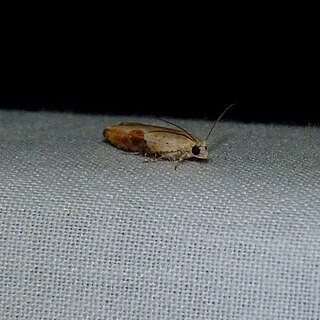
Pseudexentera costomaculana is a species of moth of the family Tortricidae. It is found in North America.

Sciota subcaesiella, the locust leafroller moth, is a species of moth of the family Pyralidae. It is found in North America, including Maryland, New Jersey, Oklahoma, Iowa, North Carolina, South Carolina, Georgia, Alabama, Mississippi, Maine, New Hampshire, New York, Massachusetts, Pennsylvania, the District of Columbia, Virginia, Tennessee, Illinois, Missouri, Arkansas, Nova Scotia and Ontario.

Dioryctria zimmermani, the Zimmerman pine moth, is a moth of the family Pyralidae. It is found from southern Canada and the north-eastern and Great Lakes areas of the United States. There is a disjunct population in eastern Nebraska.
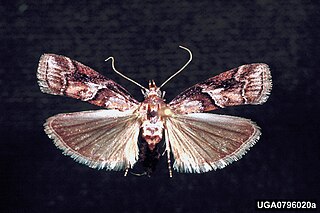
Dioryctria clarioralis, the blister coneworm moth, is a moth of the family Pyralidae. It is found in the eastern United States, including Florida, New Jersey and Virginia.

Oligocentria lignicolor, the white-streaked prominent moth or lacecapped caterpillar, is a moth of the family Notodontidae. It is found in North America, including Connecticut, Georgia, Illinois, Louisiana, Massachusetts, Mississippi, Missouri, New Brunswick, New Jersey, New York, North Carolina, Oklahoma and Pennsylvania.
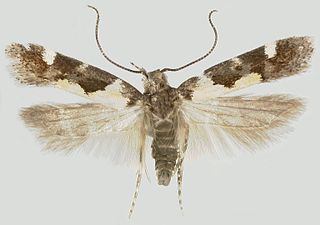
Stegasta bosqueella is a species of moth of the family Gelechiidae. It is found in North America, including Alabama, Florida, Georgia, Illinois, Iowa, North Carolina, Oklahoma, South Carolina, Texas and Virginia.

Pococera robustella, the pine webworm moth, is a species of moth of the family Pyralidae. It is found in southern Canada and the eastern United States from Minnesota to New England and south to Florida.

Dioryctria albovittella, the pinyon tip moth, is a species of moth of the family Pyralidae. It is found in North America including New Mexico.

Dioryctria ebeli, the south coastal coneworm moth, is a species of moth of the family Pyralidae. It is found in the US states of Florida, the southern parts of South Carolina, Georgia, Alabama, Massachusetts, and south-eastern Louisiana.

Digrammia gnophosaria, the hollow-spotted angle, is a species of moth of the family Geometridae. It is found in Illinois, Louisiana, Minnesota, New Jersey, North Carolina, Oklahoma, Texas and Wisconsin.
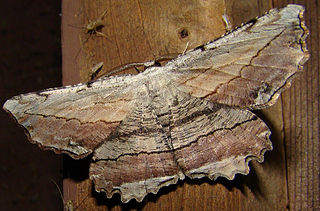
Lytrosis unitaria, the common lytrosis moth, is a species of moth of the family Geometridae. It is found in North America, including Arkansas, Georgia, Iowa, Massachusetts, New Hampshire, New Jersey, New York, North Carolina, Ohio, Oklahoma, Ontario, Pennsylvania, South Carolina, Tennessee, Texas, Virginia, West Virginia and Wisconsin.

Dioryctria disclusa, the webbing coneworm or rusty pine cone moth, is a species of moth of the family Pyralidae. It is found in North America from New Brunswick to Florida, west to Texas and north to Manitoba.
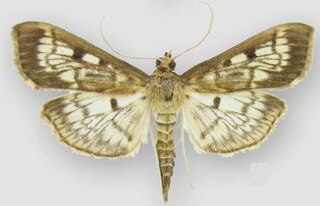
Herpetogramma thestealis is a species of moth of the family Crambidae. It is found in most of North America.

Condylolomia participalis, the drab condylolomia moth, is a species of snout moth in the genus Condylolomia. It was described by Augustus Radcliffe Grote in 1873. It is found in eastern North America, from southern Quebec to North Carolina, west to Nebraska and Minnesota.

Argyrotaenia juglandana, the hickory leafroller moth, is a species of moth of the family Tortricidae. It is found in North America, where it has been recorded from Alabama, Arkansas, Florida, Illinois, Indiana, Kentucky, Louisiana, Maryland, Mississippi, Missouri, New Hampshire, New York, North Carolina, Ohio, Ontario, Pennsylvania, Quebec, Tennessee, Texas, West Virginia and Wisconsin. The habitat consists of deciduous woodlands and parks where hickory grows.
Prionapteryx nebulifera, the clouded veneer moth, is a moth in the family Crambidae. It was described by Stephens in 1834. It is found in North America, where it has been recorded from Florida, Georgia, Maryland, Michigan, New Hampshire, Ontario, South Carolina and Wisconsin.

Meganola phylla, the coastal plain meganola moth, is a moth of the family Nolidae. It is found in North America, where it has been recorded from Alabama, Florida, Georgia, Illinois, Indiana, Maine, Maryland, Mississippi, New Jersey, North Carolina, Ohio, Oklahoma, Ontario, South Carolina, Tennessee, Virginia and West Virginia.




















